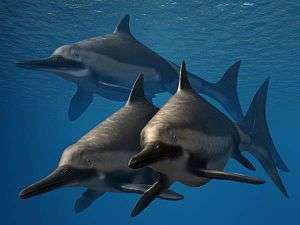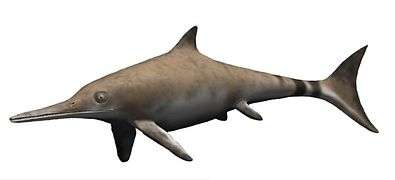Ichthyosaurus
| Ichthyosaurus Temporal range: Late Triassic - Early Jurassic, Rhaetian–Pliensbachian | |
|---|---|
| | |
| Fossil specimen of I.communis | |
| Scientific classification | |
| Kingdom: | Animalia |
| Phylum: | Chordata |
| Class: | Reptilia |
| Order: | †Ichthyosauria |
| Family: | †Ichthyosauridae |
| Genus: | †Ichthyosaurus De la Beche & Conybeare, 1821 |
| Type species | |
| †Ichthyosaurus communis Conybeare, 1822 | |
| Species | |
Ichthyosaurus (derived from Greek ιχθυς/ichthys meaning 'fish' and σαυρος/sauros meaning 'lizard') is a genus of ichthyosaurs from the late Triassic and early Jurassic (Rhaetian - Pliensbachian[2]) of Europe (Belgium, England, Switzerland) and Asia (Indonesia). It is among the best known ichthyosaur genera, with the Order Ichthyosauria being named after it.[3][4][5] Ichthyosaurus was the first complete fossil to be discovered in the early 19th century by Mary Anning in England.[6]

Description

Ichthyosaurus were smaller than most of their relatives, with individuals measuring up to 2 metres (6.6 ft) in length. Hundreds of well-preserved, fossilised skeletons have been found in Jurassic rock at Holzmaden, Germany. Some of the bones were still articulated. Some fossils still had baby specimens inside them, indicating that Ichthyosaurus was viviparous. Similar finds in the related Stenopterygius also show this.[7][8] The German fossils also featured the outline of Ichthyosaurus's skin, revealing that it had a fleshy dorsal fin on its back and a large caudal fin. Other ichthyosaur fossils showed this feature was not limited to Ichthyosaurus.
Palaeobiology

Ichthyosaurus ear bones were solid, probably transferring water vibrations to the inner ear. Still, hunting by sight was the creature's main feeding activity; it had huge, sensitive eyes, protected by bony shields. Coprolites of Ichthyosaurus reveal that its diet consisted of fish and squid.[9]
It was initially believed that Ichthyosaurus laid eggs on land, but fossil evidence shows that in fact the females gave birth to live young. As such, they were well-adapted to life as fully pelagic organisms (i.e. they never came onto land). The babies were born tail first to prevent them from drowning in the water.[7]

Classification
The cladogram below follows the topology from a 2010 analysis by Patrick S. Druckenmiller and Erin E. Maxwell.[10]
| Thunnosauria |
| ||||||||||||||||||||||||||||||||||||||||||||||||||||||||||||||||||||||||
| |
Poem
| German Wikisource has original text related to this article: |
Joseph Victor von Scheffels poem Der Ichthyosaurus describes its extinction in humouristic verses. A monument on Hohentwiel cites it as well.[12] The poem has been translated among others by Charles Godfrey Leland [13] Some of the stanzas:
'The rushes are strangely rustling,
The ocean uncannily gleams,
As with tears in his eyes down gushing,
An Ichthyosaurus swims.
'He bewails the frightful corruption
Of his age, for an awful tone
Has lately been noticed by many
In the Lias formation shown.
...
'The Plesiosaurus, the elder,
Goes roaring about on a spree;
The Pterodactylus even
Comes flying as drunk as can be.
'The Iguanodon, the blackguard,
Deserves to be publicly hissed,
Since he lately in open daylight
The Ichthyosaura kissed.
'The end of the world is coming,
Things can't go on long in this way;
The Lias formation can't stand it,
Is all that I've got to say!'
...
And this petrifideal ditty?
Who was it this song did write?
'Twas found as a fossil album leaf
Upon a coprolite.
See also
References
- 1 2 Dean R. Lomax; Judy A. Massare (2016). "Two new species of Ichthyosaurus from the lowermost Jurassic (Hettangian) of Somerset, England". Papers in Palaeontology. Online edition. doi:10.1002/spp2.1065.
- ↑ Dean R. Lomax (2010). "An Ichthyosaurus (Reptilia, Ichthyosauria) with gastric contents from Charmouth, England: First report of the genus from the Pliensbachian". Paludicola. 8 (1): 22–36.
- ↑ Maisch MW, Matzke AT. 2000. The Ichthyosauria. Stuttgarter Beiträge zur Naturkunde Serie B (Geologie und Paläontologie) 298: 1-159
- ↑ McGowan C, Motani R. 2003. Ichthyopterygia. – In: Sues, H.-D. (ed.): Handbook of Paleoherpetology, Part 8, Verlag Dr. Friedrich Pfeil, 175 pp., 101 figs., 19 plts; München
- ↑ Maisch MW, Reisdorf AG, Schlatter R, Wetzel A. 2008. A large skull of Ichthyosaurus (Reptilia: Ichthyosauria) from the Lower Sinemurian (Lower Jurassic) of Frick (NW Switzerland). Swiss Journal of Geosciences 101: 617-627.
- ↑ Essesials of Anthropology 6th addition
- 1 2 Böttcher R. 1990. Neue Erkenntnisse über die Fortpflanzungsbiologie der Ichthyosaurier. Stuttgarter Beiträge zur Naturkunde Serie B (Geologie und Paläontologie) 164: 1-51
- ↑ Martill D.M. 1993. Soupy Substrates: A Medium for the Exceptional Preservation of Ichthyosaurs of the Posidonia Shale (Lower Jurassic) of Germany. Kaupia - Darmstädter Beiträge zur Naturgeschichte 2: 77-97
- ↑ Palmer, D., ed. (1999). The Marshall Illustrated Encyclopedia of Dinosaurs and Prehistoric Animals. London: Marshall Editions. p. 80. ISBN 1-84028-152-9.
- ↑ Michael W. Maisch and Andreas T. Matzke (2003). "Observations on Triassic ichthyosaurs. Part XII. A new Lower Triassic ichthyosaur genus from Spitzbergen". Neues Jahrbuch für Geologie und Paläontologie Abhandlungen. 229: 317–338.
- 1 2 Arkhangel’sky, M. S., 1998, On the Ichthyosaurian Genus Platypterygius: Palaeontological Journal, v. 32, n. 6, p. 611-615.
- ↑ Werkkatalog Sieckes (PDF; 7,7 MB)
- ↑ Charles Godfrey Leland, Gaudeamus! Humorous Poems by Joseph Viktor von Scheffel, Ebook-Nr. 35848 on gutenberg.org

